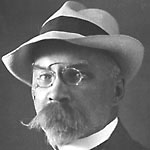
Rihards Zarinš
Encyclopedia

Life
He was born in Kocēni and grew up in LīgatneLigatne
Līgatne is a town on the Gauja River, in Latvia. The village of Līgatne was built around the paper mill, still extant, on the River Līgatne in the 19th century.-Līgatne Nature Trails:...
and later in Grīva
Griva
Griva was a Serbian and former Yugoslav hard rock band from Novi Sad.-1982—1992:The band was formed in 1982 by former Ibn Tup members, Zlatko Karavla and Josip Sabo . The first lineup also featured Zoran Gogić , Laslo Novak , and Đorđe Jovanović...
. He pursued his studies in St. Petersburg, where he graduated in 1895 from the Stieglitz
Alexander von Stieglitz
Baron Alexander von Stieglitz was a Russian philanthropist and financier. He was the first governor of the State Bank of the Russian Empire, the predecessor organization to today's Central Bank of the Russian Federation.-Early life and education:...
Central School for Technical Drawing. He then went on to further studies in Berlin, Munich
Munich
Munich The city's motto is "" . Before 2006, it was "Weltstadt mit Herz" . Its native name, , is derived from the Old High German Munichen, meaning "by the monks' place". The city's name derives from the monks of the Benedictine order who founded the city; hence the monk depicted on the city's coat...
, Vienna
Vienna
Vienna is the capital and largest city of the Republic of Austria and one of the nine states of Austria. Vienna is Austria's primary city, with a population of about 1.723 million , and is by far the largest city in Austria, as well as its cultural, economic, and political centre...
, where he studied lithography, and Paris, where he honed his skills in watercolour and pastels.
He returned to Russia where he was employed by the Russian Imperial Printing Office in St. Petersburg for 20 years, acting as technical director. From 1905 he was in charge of designing state papers. In 1919, he returned to newly independent Latvia
Latvia
Latvia , officially the Republic of Latvia , is a country in the Baltic region of Northern Europe. It is bordered to the north by Estonia , to the south by Lithuania , to the east by the Russian Federation , to the southeast by Belarus and shares maritime borders to the west with Sweden...
where he was appointed director of the government printing house. He held that position for over 14 years and retired at the beginning of 1934. After a stroke, he lost his ability to speak; however, he continued to draw until the last day of his life.
Œuvre
Zariņš was one of the best-known Latvian graphic artists. His first works appeared in the early 1890s on the pages of the then-popular Latvian-language magazine, Austrums (The East), when he was still a student at the Stieglitz art school. He dedicated a great amount of time in the study of folk ornamentation, and under his leadership, the state publishers produced a monumental work on Latvian decorative arts.During his career, the artist designed many stamps of the Russian Empire
Russian Empire
The Russian Empire was a state that existed from 1721 until the Russian Revolution of 1917. It was the successor to the Tsardom of Russia and the predecessor of the Soviet Union...
, Soviet Russia
Russian Soviet Federative Socialist Republic
The Russian Soviet Federative Socialist Republic , commonly referred to as Soviet Russia, Bolshevik Russia, or simply Russia, was the largest, most populous and economically developed republic in the former Soviet Union....
, Belarusian People’s Republic, and Latvia. He is an author of the very first Soviet stamps issued in 1918.
Zariņš was a prolific artist who produced many book illustrations, engravings and lithographs. His oeuvre
Work of art
A work of art, artwork, art piece, or art object is an aesthetic item or artistic creation.The term "a work of art" can apply to:*an example of fine art, such as a painting or sculpture*a fine work of architecture or landscape design...
also contains drawings, water-colour painting, and caricatures. Among his works of applied art are the design of the Latvian coat of arms
Coat of arms of Latvia
The Latvian national coat of arms was formed after the proclamation of an independent Republic of Latvia on November 18, 1918, and was officially adopted on June 16, 1921. It was especially created for its independent statehood...
as well as several designs for bank notes issued by the Printing Office, and several coins of the Latvian lats
Latvian lats
The lats is the currency of Latvia. It is abbreviated as Ls. The lats is sub-divided into 100 santīmi ....
.

